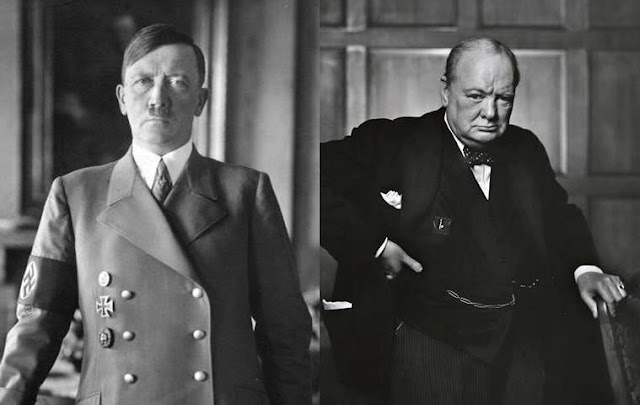The Führer and the British Bulldog: Contrasting Adolf Hitler and Winston Churchill as World Leaders
 |
| Adolf Hitler and Winston Churchill Photo by The Indian Express |
The Führer and the British Bulldog
World
War II, hailed as the deadliest war in history, also brought about two of the
most powerful leaders the world has ever known: Adolf Hitler and Winston
Churchill. From 1939 – 1945, the Second World War brought carnage on countries
from Europe all the way to Northern Africa – virtually annihilating countries across
the globe. (HISTORY, 2018). There are various claims on how World War II
actually started such as the Germany’s resistance towards the Treaty of
Versailles (BBC, 2018) or Italy’s
invasion of Ethiopia, among others (HistoryNet, 2018). Theoretically, however,
the Second World War was said to be caused by Germany’s invasion of Poland on
September 01, 1939 (Grattan, 2016; BBC, 2018).
Hitler then, was the Axis forces’ Führer; while on the other
hand, Churchill was The British Bulldog
of the Allied forces. Not only were they on opposite camps during the war, both
also have very contrasting and distinct styles when it comes to leadership.
This paper, then, hopes to understand the differences on their emergence and effectiveness
as leaders – all these, ultimately influencing the outcome of the war and the
shape of history.
The
interactional approach is the best
lens to look at how both these world leaders has emerged as it integrates both
their personality traits and the situational context surrounding their rise to
power. To fully understand the development of Hitler’s personality, it is
crucial to understand how he was raised in childhood. In his autobiography
(Mein Kampf, 1925), he recounts how his parents exhibited traditional German
values. His father was a “dutiful civil servant”, albeit an unfeeling,
alcoholic husband; while on the other hand, his mother was selflessly devoted
to them. This made Hitler adore his mother and fear his father. His parents’
(particular his father’s) parental style was characterized by rigidity,
obedience, and physical punishment; thus resulting to his “avoidant and
anxious” feelings toward his father (Hyland, Boduszek, & Kielkiewicz,
2011). All these then, defined his
attachment style and personality.
Historically, Adolf
Hitler was determined to be typically “impulsive, egocentric … aggressive, and
non - empathic” (Hyland, Boduszek, & Kielkiewicz, 2011). This may mirror
Hitler’s self-efficacy, assertiveness and dominance, which are traits more
closely associated with leadership emergence (Forsyth, 2010). This means that
Hitler had the strong desire to control his environment and other people and
usually expressed himself forcefully (Smith & Foti, 1998, as cited in
Forsyth, 2010). Hitler’s authoritarian personality may have also contributed to
his high ethnocentric tendencies
which led him to believe that his own ethnic and cultural group was superior
above everyone else’s (Myers & Twenge, 2017). This can be seen when Hitler
led the Deutsche Arbeiterpartei (German
Workers’ Party or Nazi Party) as his
initial step to power on September 1919. This Nazi Party espoused Aryan
Supremacy and anti-Semitic ideologies which
discriminated the Jews, leading to the Holocaust killings (HISTORY, 2018).
Erich Fromm (1973, as cited in Hyland, Boduszek, & Kielkiewicz, 2011) also
characterized Hitler as intensely narcissistic
due to his unconscious, unresolved issues with authority figures such as his
father. This may mean that Hitler was more than likely to take on leadership
during “turbulent situations” wherein fame is due to intense competition among
rivals. This is evidenced by how Hitler is one of the major instigators of the
Second World War. Furthermore, Hitler was characteristically “arrogant, self –
absorbed, hostile, and very self-confident” (Rosenthal & Pittinsky, 2006,
as cited in Forysyth, 2010). Hitler’s initiative for leadership, then, can be
seen as his grandiose desire of establishing the Third Reich to propel Germany
from the threats and failures it had
endured during the First World War (Hyland, Boduszek, & Kielkiewicz,
2011; HISTORY, 2009) - making this the situational context as to why Hitler
took on the leadership role during the Second World War.
Winston Churchill, on
the other hand, rose to power majorly due to the situation of Britain during
World War II. On 10th May,
1940, Germany started invading the Low Countries and France and the Commons
began to doubt the government’s campaign for appeasement. Thus, Neville
Chamberlain, the prime minister at the time, resigned, and Lord Halifax (the
choice of the Conservatives) declined to take his place. Inevitably, it was
Churchill who took on the job as the new prime minister. In terms of
personality, psycho-historical analysis characterized Churchill as a sensation
seeker, which refers to a person’s “capacity and desire for variety, novelty,
and intensity of experience” (Arnett, 1991). This can be interpreted as Big
Five’s openness (or being “open to
experience”) and a character strength
such as bravery (Forsyth, 2011; Simpson, 2015). This is exemplified by the fact
that for him, leading Britain at this time of great adversity was the
“realization of his destiny” – the true measure of his worth as a leader and a
politician (Best, 2011). Churchill was
also conscientious of his public
persona and how he dealt with other people; thus, he was respected by the
aristocrats and well –received by the masses who were suffering the
consequences of the war (Howells, 2013). This can be interpreted as Churchill’s
self-monitoring tendencies where he was
concerned with enhancing his image and status, therefore adapting his actions
to the current needs of the situation (Bedeian & Day, 2004, as cited in
Forsyth, 2010). He did this by taking notice of his physical appearance, such
as wearing sensible, practical outfits when working, thereby building their
trust (Howells, 2013). Finally, the character
strength that was worth noting and perhaps the most salient one was his strong
communications skills (Howells, 2013; Roberts, 2011). In his speeches, he knew exactly what to say
and when to say it – this adaptive character one of the hallmarks of a great
leader (Forsyth, 2010).
Now that they were
established as leaders, they must then work hard to become effective ones. Hitler
and Churchill’s leadership effectiveness can be explained by participation theories. It argues that leaders “communicate with other groups,
set goals, and have a command - and – control” leadership style; wherein
leaders give the directions and the members or subordinates follow (Forsyth,
2010).
Not surprisingly, Adolf Hitler was found to
adopt an authoritarian or autocratic leadership style (Megargee, 2011). These
leaders usually do not take inputs from others in making decisions and does not
openly discuss long-range goals with the group. In other words, such leaders
emphasized on their authority and assigned who would work in specific projects
(Forsyth, 2010). For Hitler, this comes as the Führerprinzip (Leader
Principle), wherein he wanted to command personally, with the ultimate
authority resting in him and this led to his generals being overly cautious
around him, limiting their communication. He was also largely ignorant of “military
affairs and foreign cultures” and often relied on instinct when making decisions.
This “indecisiveness and stubbornness” in leadership, exemplified when he held
off the military decision of attacking Kursk from April to July of 1943, and by
that time, the Soviets were already prepared. Still, his subordinates followed him
or were even apathetic toward these flaws, simply because they believed in his
initiative in achieving the “national desire” of winning the war which other
leaders have just attempted to do before. Thus, even though his subordinates
had the military skills and expertise, Hitler still had the final say on who
was assigned to specific tasks. This ultimately led to the downfall of the
Germans in the Second World War (Megargee, 2011; Roberts, 2011; Hyland,
Boduszek, & Kielkiewicz, 2011).
On the other hand, Winston
Churchill characteristically adopted a democratic leadership style (Roberts,
2011; Best, 2011), which ensures that all members of the group were allowed to
make their own choice and that major decisions were discussed by the entire
group. Furthermore, democratic leadership “encourages an egalitarian
atmosphere” (Forsyth, 2010) wherein all members are given equal rights and
opportunities (Afolayan, 2015). This is
evidenced by his British Chiefs of Staff and chairman Field – Marshal Lord
Alanbrooke being able to stand up to him.
Churchill was also considered as one of the most inspirational and
transformational leaders in history (Roberts, 2011), his words boosting
Britain’s morale in a time of great adversity and uncertainty.
Overall, both these
world leaders were authentic (Forsyth, 2010) in their causes and beliefs, both
having a strong sense of purpose (Roberts, 2011): Hitler, the Aryan supremacy and Churchill,
saving his country from the war. However, it was their differences in
leadership styles which determined who will go down in history as the victor;
or as Churchill had put it: “The price of greatness is responsibility.”
.
References
Afolayan, A. L. (2015). Egalitarianism. In Encyclopedia of Global Bioethics,
Springer, DOI: 10.1007/978-3-319-05544-2_166-1}
Best, G. (2011). Winston Churchill: Defender of
Democracy. Retrieved from the BBC website: http://www.bbc.co.uk/history/worldwars/wwtwo/churchill_defender_01.shtml on 12 September, 2018.
Forsyth, D. (2010). Group Dynamics. In Leadership (pp. 255 - 259). CA:
Wadsworth, Cengage Learning
Grattan, R. F. (2016). Management Research during
World War II. DOI: 10.1093/OBO/9780199846740-0021
HISTORY (2009). Nazi Party. Retrieved from HISTORY
website: https://www.history.com/topics/world-war-ii/nazi-party on 12 September, 2018.
HISTORY (2018). World War II. Retrieved from HISTORY
website: https://www.history.com/topics/world-war-ii on 11 November, 2018.
HISTORY (2009). Adolf Hitler. Retrieved from HISTORY
website: https://www.history.com/topics/world-war-ii/adolf-hitler-1 on 12 September, 2018.
HistoryNet (2018). World War II. Facts, information
and articles about World War II, 1939-1945 Retrieved from HistoryNet website: http://www.historynet.com/world-war-ii on 11 September, 2018.
Howells, S.H. (2013). CHURCHILL, LEADERSHIP AND THE
WAR(2) – The Leader as Communicator. Retrieved from https://winstonchurchill.org/publications/finesthour/finest-hour-158/churchill-leadershipand-the-war-2-the-leader-as-communicator/
on 13 September, 2018.
Hyland,P., Boduszek, D., & Kielkiewicz, K.
(2011). A Psycho – Historical Analysis of Adolf Hitler: The Role of Personality,
Psychopathology, and Development. Psychology
& Society, 4(2), 58 – 63
Megargee, G. (2011). Hitler’s Leadership Style.
Retrieved from BBC History website: http://www.bbc.co.uk/history/worldwars/wwtwo/hitler_commander_01.shtml on 12 September, 2018.
Myers, D. & Twenge, J. (2017). Social
Psychology. In Prejudice (p. 257).
NY: McGraw-Hill Education.
Simpson, J. (2015). Winston Churchill: How a flawed
man became a great leader. Retrieved from BBC News website: https://www.bbc.com/news/magazine-30934629 on 13 September, 2018.
Supply Chain News (2018). Six Leadership Traits of
Sir Winston Churchill. Retrieved from Supply Chain website: https://www.supplychain247.com/article/six_leadership_traits_of_sir_winston_churchill on 13 September, 2018.

Comments
Post a Comment